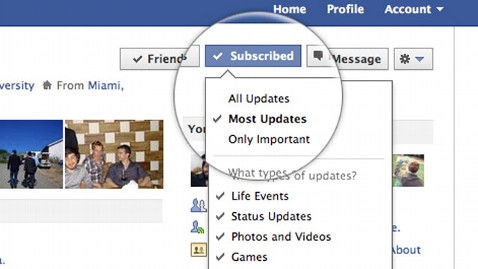Since the launch of Google+ and it's success in recruiting users, Facebook has been adding new features frantically - the new photo viewing options, video chatting, new navigation bars, and most recently, the subscription button.
This new feature allows users to subscribe to updates, including photos, statuses and more, from people they aren't already Facebook Friends with. This may not seem like a big deal yet, but it opens a door to endless potentials for brands, celebrities and thought leaders for better broadcasting. Of course, on the flip side, with potential comes a great deal of risk.

Here are a few aspects I jotted down briefly:
Pros:
1. Facebook and Twitter just had a baby.
Facebooks, Google+, and Twitter are all unique in their own user interfaces and purposes. Twitter can be considered mass broadcasting through microblogging where anyone can tweet with or read other users' tweets, given that they're not private. Google+ is a more general interface that focuses more on user sectoring, and Facebook, the friend connector, allowing friends to catch up, learn more about, and maintain relations with one another without physically hanging out.
However, this subscription button changes all that. Allowing users to follow others' updates without friending incorporates Twitter's broadcasting aspect, creating a TON of opportunities for celebrities, brands and others to broadcast their messages to a larger audience.
2. Better classifications of your friends and invisible stalking.
No more limited profiles, or friend requests. That's right. You no longer have to be friends with someone to stalk them if they enabled the subscription button. Also, you don't necessarily have to friend people you just met in order to see what they're up to until you hang out with them more.
With subscription, you can now classify your friends/ non-friends into lists so your updates are all categorized. You don't have to see updates of farmville or restaurant city any more. Just like twitter, you can categorize your news outlets, fashion tips, non-profit events, anything you wish so they are better organized. There are options to hide photo updates, video updates, and more from lists to make your feed more personalized.
Cons:
1. It just murdered the two-way connect flow
Facebook is unique in that it encourages a two-way communication. It's about friends and connection. The subscription button just threw all that out the window. It's true that Twitter itself focuses on engagement even though it's a free-for-all type of conversation, but the word "Facebook Friends" just got degraded.
2. New metrics needed
With public subscriptions, the measuring system just got complicated. Facebook Insights will have to come up with better metrics to measure subscriber activities.
3. Back to the Privacy Issue
I am sure most of everyone is social media savvy by now, but there are of course people who are still a little lost trying to catch up with all the tools bombarded their way. For people who want to use Facebook personally, the subscribe button may cause issues, as it allows non-friends to read your updates.
Changing its mission statement.
Just from first impressions, it seems to me that the subscription button is definitely a good move in terms of helping brands and celebrities work their marketing strategies. However, if Facebook were to follow its original 2008 mission of " “Facebook helps you connect and share with the people in your life.” Then the subscription button is way out of its boundaries. Its new mission statement however, became “Facebook’s mission is to give people the power to share and make the world more open and connected.” This for me makes Facebook a lot more business and revenue oriented, and a little negligent of user interests.
What are your opinions on the new Facebook Subscribe button?
What you might also be interested in:
Facebook Subscribe Button: What It Means for Each Type of User
What Facebook's new Subscribe button means to brands and businesses
The Complete Guide To Facebook’s Subscribe Button

